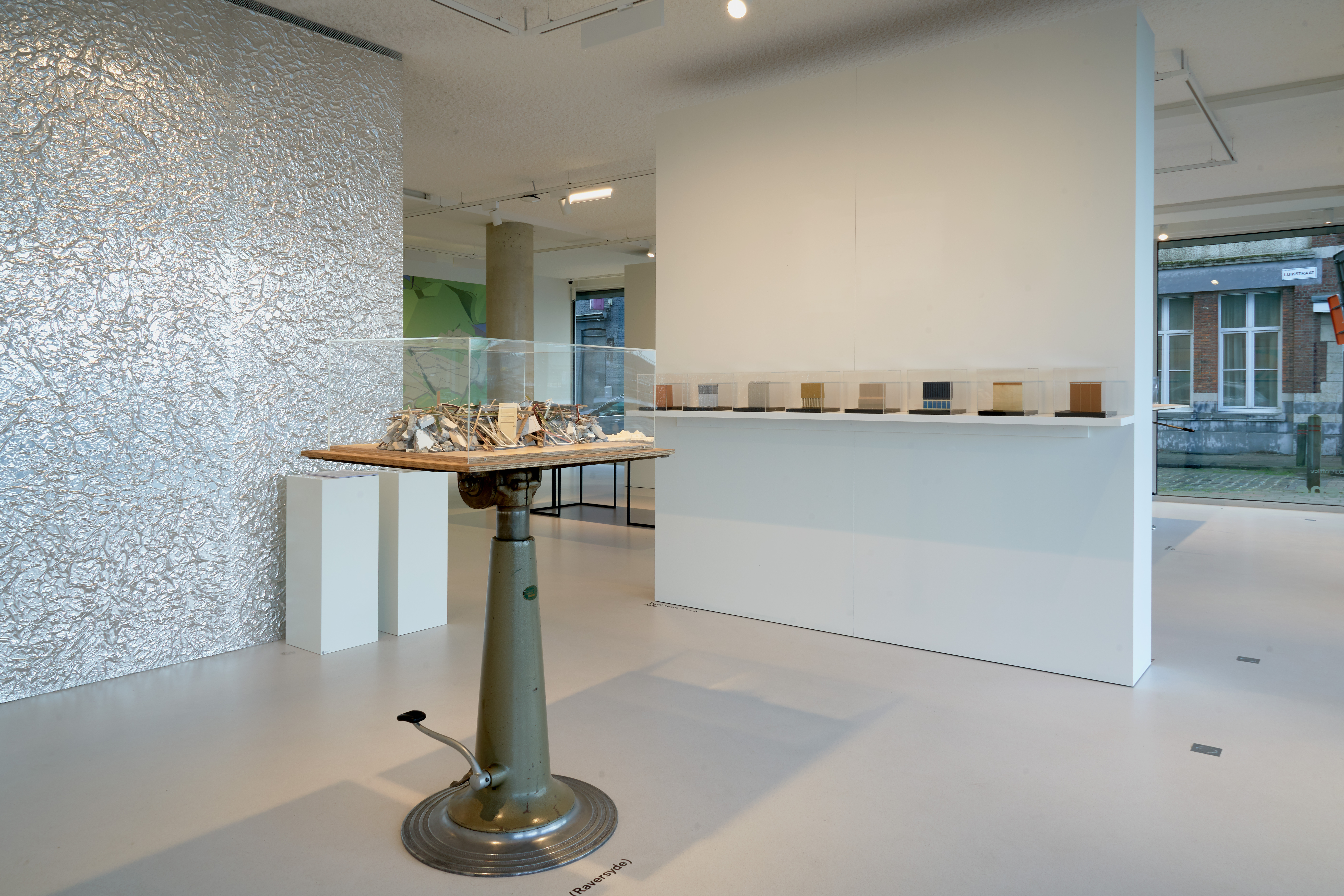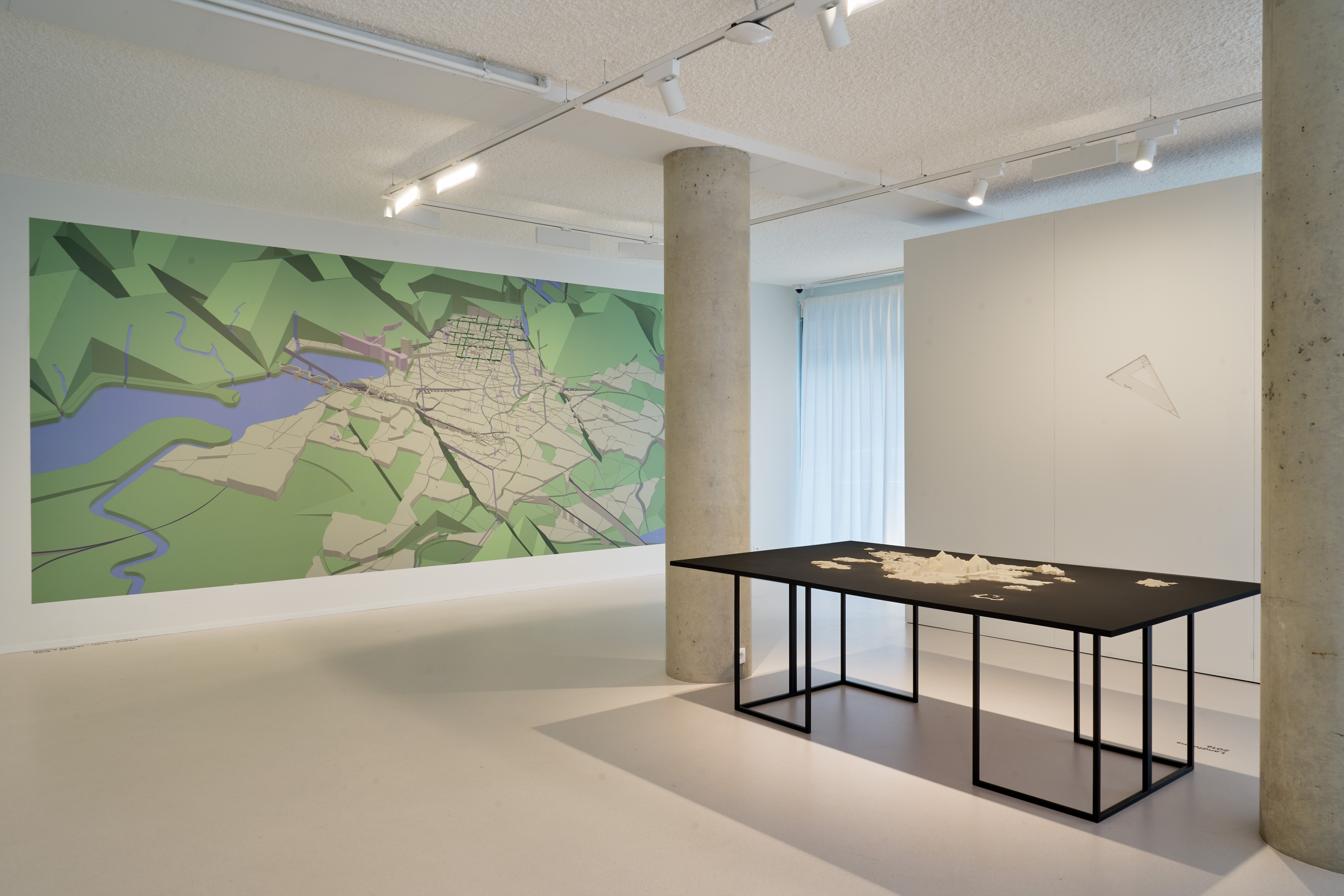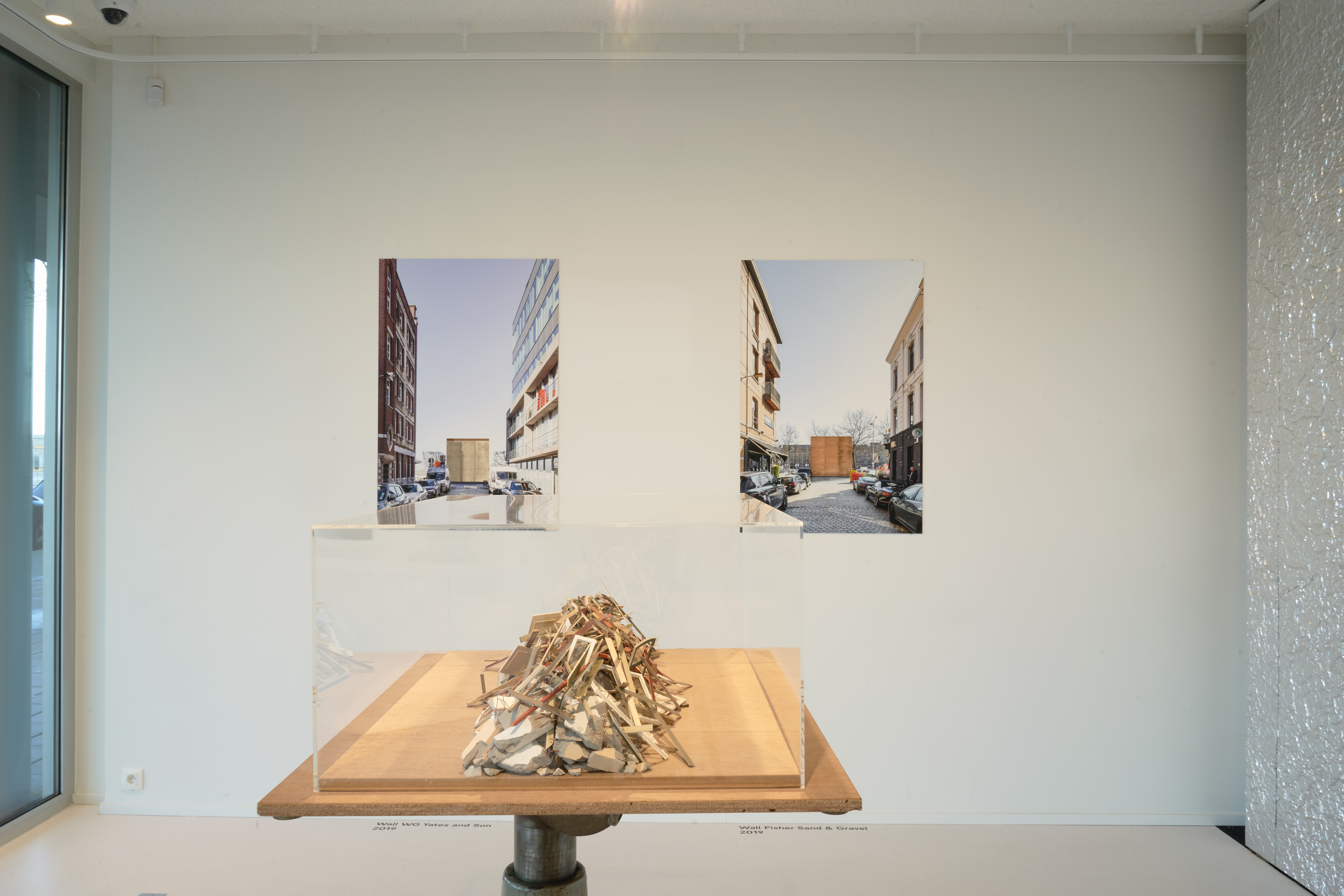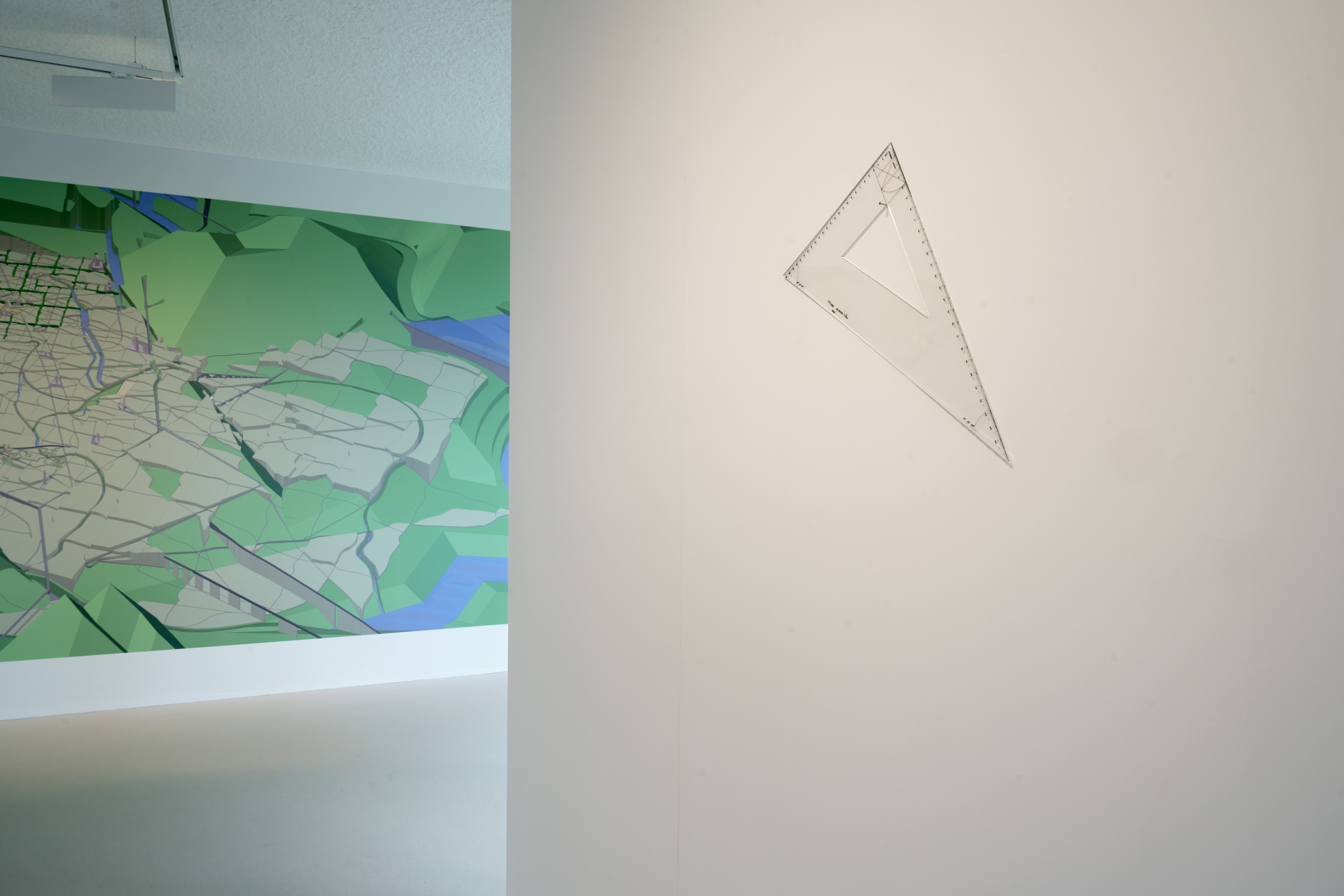
NL
I
De presentatie van werk van Luc Deleu & T.O.P. Office in de context van space for art B scene is als een symbiose van omstandigheden én noodzaak. Architect Luc Binst liep school bij Luc Deleu; in 2010 publiceerde hij een boek en in 2011 maakte hij een tentoonstelling in Cc Strombeek, waarbij toen vooral de realisatie van een grote X-constellatie met containers van Luc Deleu een opvallend teken was aan de Schelde-oever van wereldhaven Antwerpen.
Antwerpen is de thuisstad van Luc Deleu en niemand anders dan Luc Deleu weet al decennia lang de architectuur te verdenken van eng denken dat geen of weinig rekening houdt met een breed nadenken over “bouwen” in een wereld met bouwgronden die schaarser en schaarser worden.
Luc Deleu geniet vooral bekendheid in de wereld van de kunsten met tal van straffe ingrepen met containers. Containers als units – als anonieme én standaardblokken waarmee de wereldhandel via zee, spoor en (drukke) wegen op een waren-onzichtbare manier wordt georganiseerd. Luc Deleu haalde de container als het ware uit de anonimiteit en gebruikte die als kunstenaar in composities die soms heel spectaculair waren. Beroemd zijn de triomfbogen met drie containers – triomfbogen voor wie en voor wat … liet hij altijd mooi in het midden. Zijn containers lagen soms op en door elkaar in een verlaten loods alsof het een simpel en ontwapenend kinderspel betrof.
Het (aan)tonen van schaal is één van de aandachtspunten wanneer hij containers accumuleerde of grote verlichtingspalen of elektriciteitsmasten horizontaal in een ruimte of gewoon op een openbaar plein neerlegde en als urbane readymades tentoonstelde.
Deleu is architect maar laat zijn “orbanistische” ideeën ontsnappen in de vrije en van reglementen bespaarde kunstwereld. Het groots durven denken in functie van een decennialang bewustzijn van de eindige mogelijkheden van de aarde, is een extreme bezorgdheid die als een rode draad (ver)loopt in zijn ronduit fantastische oeuvre. Zijn werk is als één grote spiegel te beschouwen naar alle politieke en andere instanties die verantwoordelijkheden dragen voor het in stand houden van de aarde.
De tentoonstelling in B scene toont werken uit de periode tussen 1972 tot 2019. Het wordt een tentoonstelling waar nuchter en duidelijk wordt hoe Luc Deleu & T.O.P. Office decennia lang letterlijk op een conceptuele manier bouwden aan een “andere” organisatie van de wereld op het vlak van huisvesting van steeds meer mensen op deze wereld, die zich op één of andere manier (massaal) wensen te voeden en te verplaatsen.
De expo start met het authentieke werk Mobile Medium University (1972), een voorstel dat Luc Deleu buiten competitie voorlegde aan de Universitaire Instelling Antwerpen. Het besef van de schaarste aan grond en het feit dat de wereld voor twee derde uit water bestaat, bracht Luc Deleu op de idee de universiteit te huiswesten op vliegdekschepen. Een vliegdekschip laat uiteraard ook toe hypersnel weg te vliegen, en de aanwezigheid van topapparatuur voor communicatie was volgens Deleu een “voorafspiegeling van afstandsonderwijs”.
Dit straffe oudere werk nu naast de uit het oog verdwenen brede Schelde te kunnen tonen in de transparante hoek-ruimte van B scene is méér dan een vooruitstrevende samenloop: het geeft ook aan hoe Luc Deleus ideeën nog steeds en meer dan ooit steek en stand houden, niet alleen als voorstel maar ook als poëzie en dus als kunst. Als knipoog naar MMU is Orban Space – Academic Westbound Tour (2016) een praktische toepassing van een zeetocht in de vorm van een kaart waar de zeeroute visueel wordt voorgesteld.
Luc Deleu speelt al heel lang mee in de afdeling van weergaloze kunstenaars zoals Panamarenko – ze zijn met weinige kunstenaars die de kunst als oeuvre houdbaar houden als blijvend én betekenisvol voor mens en samenleving. De kunst van Luc Deleu en T.O.P. Office groeide vanuit een groots project, een notoir zeggingschap over de wereld die niet ophoudt actueel te zijn en te blijven.
De tentoonstelling in B scene navigeert op de meer recente denkbeelden van na de periode waarin de container centraal stond in zijn artistiek doen én die vandaag volgens de kunstenaar wordt vervangen door meer urgente en aan de actualiteit gelieerde architecturale elementen zoals de muur en barricades.
II
Kunst en de wereld betekent dat Luc Deleu zich als kunstenaar durft te herpositioneren en paden achter zich kan laten – zoals het bekend, succesvolle en herkenbare gebruik van containers – om zich vernieuwend te verhouden tot een globale wereld waarin nu “alles” kan en verrassingen realiteit worden.
De reeks Barricade is daarvan een sprekende wending. In 2016 realiseerde Deleu aan de Atlantikwall in Raversyde (Oostende) een eerste barricade als een positieve, chaotische en planloze constellatie met direct beschikbaar materialen die als een dijk of een loopgracht beschutting biedt tegen vormen van staats- en andere agressie. De barricade heeft iets van “een manifest”: ze houdt iets tegen of ze komt voor iets op. Deleu verwijst zelf naar het iconische schilderij van Eugène Delacroix La Liberté guidant le peuple (1830), waarvan wordt beweerd dat dit de eerste afbeelding is in de kunst van een barricade. Deleu eigent zich als architect/kunstenaar dit “motief” toe als een vorm van primaire architectuur, als een soort symbolische muur ter lijfelijke protectie. De barricade is een teken van hoop, (veelal) niet gebouwd maar met afval, straatmeubilair en “gevonden” stenen bij elkaar gegooid als een stevig obstakel. Het werk/de maquette BARRICADE#1(Raversyde) uit 2016 is daarvan een eerste voorbeeld.
Een muur is een obstakel – hij houdt alle vormen van mobiliteit tegen. Er staan heel wat politieke of ideologische muren in de wereld. Kunstenaar Carlos Garaicoa maakte er op het wijndomein Casetello di Ama zelfs een permanent werk over in de vorm van een index/een minipark van muren.
De verbazing was vorig jaar toch wel groot toen beelden de wereld rondgingen van president Donald Trump die een keuze overwoog uit een reeks kijkmodellen van netjes op een rij, vrijstaande gigantische stukken muur (9 m x 9 m) voor een muur aan de grens met Mexico met de bedoeling de grens te bewaken tegen illegale en ander vormen van inwijking. Het zag er op tv allemaal zeer “kunstig” uit – een presentatie zoals er ooit in Antwerpen op het Zuid een werd georganiseerd onder de titel The Sculpture Show.
Deleu maakte er een grootse maquette van! Een maquette waarin de ondeugd van Trumps intenties wordt geconverteerd in een kunstwerk met zoveel bijgedachten. Eén muur werd door Deleu uit die acht geselecteerd om in concreto te laten optrekken op het Zuid of aan de kant van de reeds “verdijkte” Schelde.
De muur komt er voorlopig niet, maar het concept is wel te zien op de tentoonstelling! De muur als negatie van vrijheid, de muur als negatie van transport en mobiliteit, de muur als een teken van onmacht en protectie van “eigen” volk en zijn kennis en kapitaal, de muur als een grens, de muur als een teken van “hier stopt het”.
Een overloopje naar de kaarten Zwischenland (2018) en Tierra Grande (2018) is hier kort te nemen. Luc Deleu dacht na over toevluchtsoorden voor de vele onfortuinlijke vluchtelingen en daarom bedacht hij de idee om voor hen aan beide zijden van alle landsgrenzen in Europa een 10 km brede zone vrij te houden. Eenzelfde voorstel voor een strook van 10 mijl aan beide zijden van de grens tussen Mexico en de VS is verankerd in eenzelfde fundamenteel denken omtrent dit probleem, dat ook een “ruimtelijk vraagstuk” is. Stroken veilig land, mooi verdeeld en geïntegreerd in Fort Europa; hetzelfde idee op de nerveuze grens tussen de VS en Mexico.
Via de prefigurerende Landforms belanden wij bij een andere primeur op deze tentoonstelling: de allereerste presentatie van Darling Springs (2016-2019), een werk gebaseerd op een onderzoek naar één van de hedendaagse problemen bij uitstek: onze mobiliteit.
In een ongelooflijk gelaagde en méér dan ooit tot de verbeelding sprekende grafisch uitgewerkte taal presenteert Luc Deleu & T.O.P. Office hier in B scene door middel van een monumentale, tegen een grote muur gekleefde print een uiterst gelaagd en verfijnd beeld van de mogelijkheden van mobiliteit. De schematisch, veellagige tekening is als een deinende wirwar waarin een mens zich als het ware na een tijd er zijn/haar weg “in en tussen” verliest en er de schoonheid en de poëzie van inziet.
De tentoonstelling transportable in B scene brengt in een relatief kleine ruimte de fascinerende wereld van Luc Deleu & T.O.P. Office samen als in een spinnenweb, waarbij alle draden in zijn werk samenkomen in een groots (ondeelbaar) oeuvre waarin een humane en grote bekommernis over het verloop en het reilen en “zeilen” van onze wereld het onderwerp is en blijft.
ENG
I
The presentation of Luc Deleu & T.O.P. Office’s work in the context of space for art B scene is like a symbiosis of circumstances and necessity. Architect Luc Binst studied with Luc Deleu; in 2010 he published a book and in 2011 he presented an exhibition in Cc Strombeek, where Deleu’s creation of a large X-constellation with containers marked Antwerp’s conspicuous presence as an international seaport on the bank of the river Scheldt. Antwerp is Deleu’s home town and for decades Deleu has accused architecture of a narrow-minded view that lacks a broad perspective on ‘building’ in a world in which building plots become scarcer and scarcer.
In the world of art Deleu is known mainly for his powerful interventions with containers. Containers as units—as anonymous and standard blocks with which global trade across the sea, by train and on (busy) roads is organized in a way that makes the merchandise invisible. Deleu has as it were stripped the container of its anonymity and as an artist he has used in at times particularly spectacular compositions. His triumphal arches made of three containers are famous—though he invariably leaves aside what purpose these triumphal arches serve or for whom he built them. Sometimes his containers were tossed on top of each other or in a jumble in an abandoned warehouse, as if they were part of a simple and disarming children’s game.
Showing and demonstrating scale was one of the things he paid special attention to as he piled up containers or put down large lampposts or electricity poles in a horizontal position in a private or public space and exhibited them as readymades.
Deleu is an architect, but he lets his ‘orbanistic’ ideas loose in the free world of art, a world spared of rules. Daring to think big—the result of having been aware for several decades of the finite potential of the earth—is Deleu’s particular preoccupation, which constitutes the leitmotif in the frankly superb oeuvre. His work is like a unique huge mirror he holds up to the political and other authorities that are responsible for the preservation of the Earth.
The exhibition in B scene features works from between 1972 and the present. It’s an exhibition that in a down-to-earth manner makes clear how Luc Deleu & T.O.P. Office have been working for decades in a conceptual manner on ‘another’ organization of the world with regard to housing an ever-growing number of people in this world, people who some way or another (and en masse) want feed themselves and move around.
The exhibition starts with the authentic work Mobile Medium University (1972), which Deleu proposed hors concours to the University of Antwerp. The awareness that building plots are scarce and the fact that two thirds of the planet is covered with water inspired Deleu to house the university on aircraft carriers. These vessels of course also make it possible to fly away ultra-fast, and in Deleu’s view the presence of the most modern communication equipment ‘foreshadowed distance learning’.
The opportunity to show this very powerful older work next to the river Scheldt (which has disappeared from sight) in the transparent corner space of B scene is more than a progressive coincidence: it also shows that Deleu’s ideas are still valid and stand up to scrutiny, more than ever for that matter—not only as proposal, but also in their quality as poetry and therefore as art. As an allusion to MMU, the work Orban Space – Academic Westbound Tour (2016) constitutes a practical adaptation of a sea trip in the shape of a map on which the route is visually presented.
For a long time now, Deleu has had his place in the gallery of unrivalled artists, which also includes for example Panamarenko; there are few of these artists who create an oeuvre that will remain and that will continue to be meaningful for individual people and our society. The art of Luc Deleu & T.O.P. Office has its origin in a grandiose project, in a notorious voice that refers to the world, a voice that is and will remain topical.
The exhibition in B scene explores the more recent ideas that developed after the period in which Deleu focussed on the container in his artistic practice, as now according to the artist the container has been replaced by more urgent and topical architectural elements, such as the wall and barricades.
II
Art and the world, that means that as artist Luc Deleu dares to reposition himself and leave behind certain avenues—such as the familiar, successful and recognizable use of containers—to relate in a novel way to the global world in which nowadays ‘everything’ is possible and surprises become reality.
The series Barricade is an outstanding example of this turnabout. In 2016 Deleu created his first barricade on the Atlantic Wall in Raversyde (Ostend) as a positive, chaotic and planless constellation with directly available materials, which like a dam or trench protects against aggression, by the state or by other agents. The barricade has something of a ‘manifesto’: it stops something or it stands up for something. Deleu himself refers to Eugène Delacroix’ iconic painting Liberty leading the people (1830), which is said to be the first depiction of a barricade in art. As an architect/artist, Deleu appropriates this ‘motif’ as a form of primary architecture, as a sort of symbolic wall for physical protection. The barricade is a sign of hope, (often) not built, but thrown together with scrap material, street furniture and ‘found’ stones, piled up as a solid obstacle. The work/scale model BARRICADE#1(Raversyde) from 2016 is the first example of this.
A wall is an obstacle. It stops all forms of mobility. There are lots of political or ideological walls in this world. On the winemaking domain of Casetello di Ama, the artist Carlos Garaicoa has even created a permanent work about them in the shape of an index/miniature park of walls.
Last year there was universal amazement when images where shared all around the world of US president Donald Trump who was considering what wall to choose from an array of models of huge freestanding pieces of walls (9 m x 9 m) for the wall he would like to construct at the Mexican border, with the aim to prevent illegal and other forms of immigration. On television it all looked very ‘artistic’, a bit like The Sculpture Show that was once organized in the South District of Antwerp.
Deleu turned this in a huge scale model, in which the wickedness of Trump’s intentions was turned into a work of art that called forth so many associations! Deleu selected one of the eight walls to be actually built in the South District or on the Scheldt embankment.
For the time being, the wall won’t be built, but the concept is on view at the exhibition! The wall as the negation of freedom, the wall as the negation of transport and mobility, the wall as a sign of powerlessness and protection of ‘our own people’ and its knowledge and capital, the wall as border, the wall as a sign ‘this is where it stops’.
It’s easy to jump from here to the maps Zwischenland (2018) and Tierra Grande (2018). Deleu reflected on the creation of safe havens for the many unlucky refugees. He therefore came up with the idea to reserve a 10 km wide zone on both sides of all European borders for them. A similar proposal to reserve a 10 mile wide zone on both sides of the border between Mexico and the US is anchored in the same fundamental approach to this problem, which in fact also involves an issue of ‘space’. Save havens, neatly distributed over and integrated in Fortress Europe; the same idea on the nervous border between the US and Mexico.
After the prefiguration of the Landforms, we approach the work Darling Springs (2016-2019), which is on view for the first time. The work is based on research in one of our most pressing contemporary problems: mobility. In a tremendously layered graphic language that fires the imagination, Luc Deleu & T.O.P. Office present an equally layered and sophisticated image of the potential of mobility in this monumental print that is glued on the wall. The schematic, multilayered drawing is like a heaving jumble ‘in and between’ which after some time humans as it were lose their way and start to see its beauty and poetry.
In a relatively small space, the exhibition transportable in B scene brings together the fascinating world of Luc Deleu & T.O.P. Office like in a spider’s web, of which all the threads meet in a huge (indivisible) oeuvre, in which a profound humane preoccupation with the ins and outs of the world are and remain the subject.







By Luc Binst and Luk Lambrecht